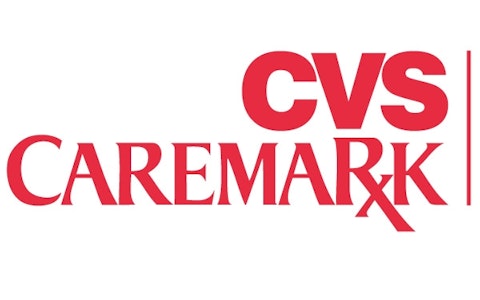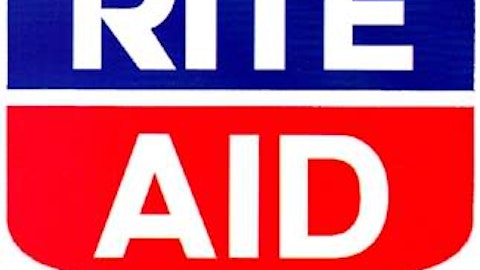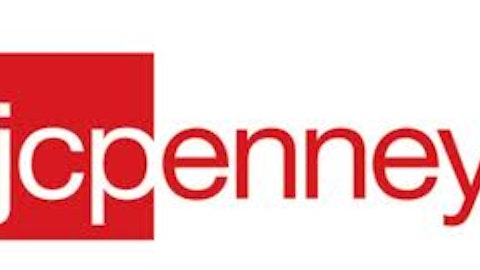New generic drugs drove store sales across the pharmacy market, and the anticipated influx of newly-insured patients due to the Affordable Care Act provides a nice platform for pharmacy revenue growth.
This is an exciting sector to own stock in over the long term. There will be fits and starts in the implementation of the new insurance exchanges, so the next couple of years will be rocky. Rite Aid Corporation (NYSE:RAD) and CVS Caremark Corporation (NYSE:CVS) are stocks to buy and hold; Walgreen Company (NYSE:WAG) should be avoided for now.
Rite Aid
Rite Aid runs on a fiscal year from February to March, so the fourth quarter (Q4) of FY 2013 is most comparable to the first quarter (Q1) of calendar year 2013. In Q3 of 2013, Rite Aid returned to profitability, and in Q4 of FY 2013 returned a net income of over $123 million, which pushed Rite Aid’s fiscal year into the black for the first time since 2007. Management reported Q4 same-store sales growth of 0.3 percent and a three percent increase in same store prescription count. At 28.8 percent and 2.6 percent, respectively, gross and operating margins for fiscal year (FY) 2013 were the highest since at least 2005, according to Morningstar.
I am also pleased to see Rite Aid Corporation (NYSE:RAD)’s improvements in customer service on a national level, with the American Customer Satisfaction Index rating Rite Aid the highest of the major chains at 77% customer satisfaction, as compared to Walgreen Company (NYSE:WAG) at 76% and CVS Caremark Corporation (NYSE:CVS) at 75%. All three chains improved year-over-year.
Rite Aid’s Wellness+ loyalty program is at the core of their strategy moving forward, and given that members of the program represented 68% of Rite Aid’s Q4 pharmacy sales and 79% of front-end sales, it is understandable why. I’m confident that these repeat customers (over 50 percent of them shop at Rite Aid every week) will provide a solid base of consistent revenue for Rite Aid in the future. A dispute between Walgreen Company (NYSE:WAG) and Express Scripts provided new customers for Rite Aid, and management estimates that they are “retaining approximately 75% to 80%” of the customers gained from that dispute.”
Red flags
Management estimates that one new store will be opened in FY 2014, 50 stores will be closed, and 400 will be remodeled. Management does expect a three percent sales increase from remodeled stores, but the growth weakness is a red flag to me.
Overall
I like what I’m seeing overall; closing underperforming stores is difficult but will be a key part of increased profitability moving forward. The Price/Earnings (P/E) ratio for the past twelve months is 24, which is a little low for a growth stock (and a buy signal to my mind), especially when Morningstar indicates a forward P/E of six based on anticipated earnings. The market doubtless remains concerned that profitability will not be sustainable (a legitimate fear); however, management has a good game plan and is executing it well, so I would recommend buying before the price runs up further.
CVS Caremark
CVS Caremark Corporation (NYSE:CVS)’s Maintenance Choice program, which provides script dispensing for people with chronic conditions, saw meaningful growth year-over-year (16.3 million customers as of Q1 2013, as compared to 10.5 million in Q1 2012).
CVS also benefited from the Walgreen Company (NYSE:WAG) – Express Scripts fiasco, and management reports that they are on-target to retain at least 60 percent of the Express Scripts customers gained. Same-store sales decreased by 1.2 percent due in part to the introduction of new generic drugs.
CVS Caremark Corporation (NYSE:CVS) is growing much faster than Rite Aid, with a net of 28 new pharmacies in Q1. CVS is also heavily investing in the Minute Clinic concept, which enables customers to see a doctor who can diagnose minor illnesses and write them a prescription. CVS opened nine Minute Clinics in Q1 and anticipates a total of 150 new openings in 2013, bringing the total to 800 nationwide. With clinics in only 25 states, CVS Caremark Corporation (NYSE:CVS) has a path for future growth in this concept. These clinics will see increased utilization as the Affordable Care Act ramps up. More people with insurance will steadily increase demand for non-Emergency Department primary care, which will benefit convenient clinics like the Minute Clinic.
Steady EPS growth ($2.57 for 2011 grew to $3.03 in 2012; Q1 of 2013 clocked in at $.77 compared to $.59 for Q1 of 2012) and a reasonable P/E (17.7 on trailing twelve months earnings; forward P/E is 12.5 according to Morningstar) make this an attractive stock. The small cash dividend is sustainable based on a low payout ratio and should have plenty of room to grow.
Red flags
CVS Caremark Corporation (NYSE:CVS) suffered a sanction from the Centers for Medicare and Medicaid Services (CMS) for its SilverScript Plan in January, which means no new member enrollment until the sanction is lifted. Watch this relationship the long-term; as the administrator of Medicare and Medicaid, CMS is the 800-pound gorilla of healthcare, so hopefully CVS will get the sanction lifted soon and will avoid re-offending.
Walgreen
Due to a dispute with Express Scripts that has since been resolved (but not after doing some significant damage to earnings), Walgreen reported lower earnings per share (EPS) for FY 2012 than FY 2011 ($2.42 compared to $2.92).
Walgreen Company (NYSE:WAG) operates on a fiscal year; Q3 of FY 2013 is closest to Q1 of calendar year 2013. Walgreen reported a Q3 2013 EPS of $.65, up slightly from $.62 in the year-ago quarter, which was itself a decline from $.65 in 2011. Flat earnings two years running makes me wonder about Walgreen’s ability to capitalize on future growth opportunities.
Walgreen also recently settled a Drug Enforcement Agency investigation into its painkiller dispensing practices. While Walgreen may be able to benefit from CVS Caremark’s CMS sanction, the company is also having trouble with the government. Also, despite flat earnings and the other aforementioned issues, Walgreen trades at a P/E of 20 and a forward P/E of 13.0 (the forward P/E is the highest of the three pharmacy stocks). The stock is too expensive to be a value stock, and I don’t see the earnings growth to justify classification as a growth stock.
The Foolish bottom line
Buy CVS as a safe stock with great long-term growth potential. Buy Rite Aid if you like risks in return for outsized gains (that P/E ratio indicates huge upside potential, especially given the steady increase in earnings). Avoid Walgreen for the flat earnings and the Express Scripts and DEA missteps. I lean more toward CVS due to its established spot as a leader (and with a dividend), but that is my investment preference speaking.
The article Want to Benefit From Healthcare Expansion? Buy These Pharmacy Stocks originally appeared on Fool.com and is written by Michael Douglass.
Michael Douglass has no position in any stocks mentioned. The Motley Fool has no position in any of the stocks mentioned. Michael is a member of The Motley Fool Blog Network — entries represent the personal opinion of the blogger and are not formally edited.
Copyright © 1995 – 2013 The Motley Fool, LLC. All rights reserved. The Motley Fool has a disclosure policy.


